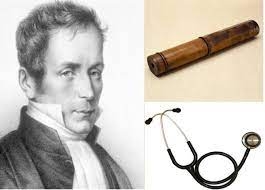
The stethoscope is the most common symbol of a doctor. No other tool is so distinctive to its profession. It aids the doctor in diagnosis and is used to monitor cardiac sounds, respiratory sounds and sometimes bowel sounds.
Before the stethoscope was invented, doctors had to put their ear directly to the patient’s chest. This caused some awkwardness between doctor and patient.
In the year 1816, an obese patient visited a French doctor named Rene-Theophile-Hyacinthe Laennec, in Paris. She was pregnant with signs of cardiac irregularities. Laennec was not able to examine the patient due to her excessive weight and thought of an innovative solution.
He folded some paper into a roll and made a hollow pipe. He put one end to the patient’s chest and the other to his ear. To his pleasant surprise he found that the beating of the heart could be heard more clearly than by the normal method. Thus, the very first stethoscope was invented.
Laennec made the first permanent stethoscope from a tube of wood 23 cm long and 4 cm wide. He described all the chest sounds he heard in his patients and linked many of them to different diseases.
The modern stethoscope is also called the acoustic stethoscope and transmits the sound via air-filled hollow tubes to the listener’s ears.
Picture Credit : Google




